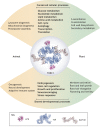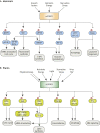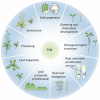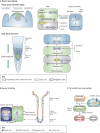TOR signaling in plants: conservation and innovation
- PMID: 29986898
- PMCID: PMC6053665
- DOI: 10.1242/dev.160887
TOR signaling in plants: conservation and innovation
Abstract
Target of rapamycin (TOR) is an evolutionarily conserved protein kinase that plays a central role in both plants and animals, despite their distinct developmental programs and survival strategies. Indeed, TOR integrates nutrient, energy, hormone, growth factor and environmental inputs to control proliferation, growth and metabolism in diverse multicellular organisms. Here, we compare the molecular composition, upstream regulators and downstream signaling relays of TOR complexes in plants and animals. We also explore and discuss the pivotal functions of TOR signaling in basic cellular processes, such as translation, cell division and stem/progenitor cell regulation during plant development.
Keywords: Cell cycle regulation; Meristem; Metabolism reprogramming; Nutrient signaling; Stem cell niche; Target of rapamycin protein kinase.
© 2018. Published by The Company of Biologists Ltd.
Conflict of interest statement
Competing interestsThe authors declare no competing or financial interests.
Figures






References
Publication types
MeSH terms
Substances
Grants and funding
LinkOut - more resources
Full Text Sources
Other Literature Sources

